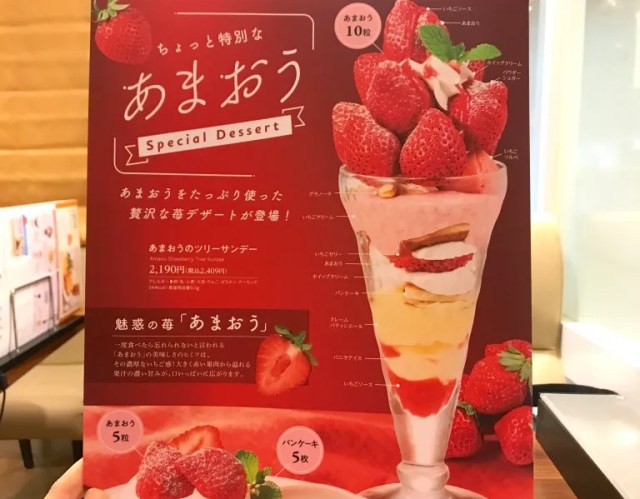
Prized Fukuoka fruit delivers joy to the taste buds, shock to the wallet.
In Japan, the 15th of the month is known to sweets fans as “Strawberry Day,” because when you put the Japanese words for one, ichi, and five, go, together, they sound like ichigo, which means “strawberry.”
Strawberry Day isn’t an officially recognized holiday, but it is a widely accepted excuse to treat yourself to some strawberry desserts, and so our reporter Mariko Ohanabatake took advantage of that opportunity this month to go get a strawberry parfait at Denny’s.
In Japan, places like Denny’s, which would be called coffee shops or diners in the U.S., are called “family restaurants.” Pretty much every family restaurant chain offers a strawberry parfait, usually a simple glass of ice cream with a few strawberry slices and a modest drizzle of fruity sauce. But what had brought Mariko to Denny’s was their new, premium-priced Amaou Tree Sundae. As the name implies, the star ingredient are Amaou strawberries, an extra-delicious, and also extra-expensive, variety grown in Fukuoka Prefecture. Even a single Amaou is considered a delicacy among fruit fans, so imagine Mariko’s joy when she saw that Denny’s gives you 10 of them in the special sundae!
But like we said, Amaou aren’t cheap, and neither is the Amaou Tree Sundae, which is priced at 2,409 yen (US$16.60). That’s a lot for a family restaurant dessert, but Mariko decided to splurge. After all, Strawberry Day comes but once a year, er, month!
Anyway, she wanted it, so as soon as the waiter came by that’s what she ordered. Then she waited…and waited…and waited some more. She watched as customers who’d come in after her received their non-Amaou Tree Sundae food, and still she waited. Granted, the restaurant was crowded, but she couldn’t help thinking it was taking a long time. Maybe the staff was short-handed that day, or maybe it was because…
…the Amaou Tree Sundae is massive! It looked more like a mountain than a tree, with the mouthwatering Amaou positioned just right so that they could all fit in the glass without any squishing, while still being a solid enough stack to prevent an Amaou avalanche.
Amaou are so named because of how red (akai), round (marui), big (ookii), and delicious (umai) they are, and you have to admit, it’s a much more appetizing name than “RRBD” would be. The sprinkling of powdered sugar made their crimson color look all the more vivid by comparison, and every single bite of strawberry was like a delivery of happiness to Mariko’s soul via her mouth.
An interesting side effect of the Amaou Tree Sundae’s presentation is that you pretty much have to eat all of the strawberries, one after another, before you can dig down to all the non-strawberry parts of the dessert. So instead of making the difficult decision of how to ration your Amaou throughout the dessert session, you start off by diving completely into indulgent luxury, and Mariko has to admit she found this liberating decadence immensely enjoyable, with the strawberry sauce and whipped cream playing palate-pleasing supporting roles.
However, after she finished eating all 10 Amaou, her spirits sagged a little. No, it wasn’t because of guilt – Mariko has no regrets about any of the strawberries she ate here, likening the experience of them to a sweet spring breeze. Nor did she have any complaints about the strawberry sorbet, strawberry cream, or crunchy granola bits that sit directly beneath the fruit. No, what bothered her was what came next as she was digging down.
At first glance, you might think you see a layer of sponge cake inside the glass in the above photo. Actually, though, that’s not sponge cake. It’s pancake.
We say “pancake,” not “a pancake,” because it’s more like a strip of shredded pancake than a fully formed mini pancake. This was what Mariko had a problem with. You might be wondering why, especially since most people’s image of restaurant pancakes in Japan are of the dessert kind, piled with chopped fruit, whipped cream, and other sweet accoutrements.
But while sponge cake is common in Japanese parfaits, pancake is pretty much unheard of. The fluffiness sort of reminded Mariko of sponge cake, but it wasn’t quite the same, making the texture feel off to her classically trained parfait sensibilities, and the pancake was also decidedly less sweet than sponge cake. The oddity of eating pancake that’s cold may have also contributed to her disappointment, as did the fact that there are multiple pancake pieces in the glass.
On the plus side, there are a few more Amaou slices waiting deeper down in the glass, plus a perfectly fine custard layer, vanilla ice cream and strawberry sauce at the very bottom.
So is the Amaou Tree Sundae worth its price? That probably depends on your ceiling in terms of how much you love strawberries, and also your tolerance for pancake as a parfait ingredient. This many Amaou strawberries, just by themselves, could easily cost you 1,000 yen at a grocery store, so in that sense, the Amaou Tree Sundae isn’t a bad value, but Mariko personally finds the inclusion of pancake unforgivable, and is keeping her fingers crossed that Denny’s will one day decide to replace it with more conventional sponge cake, even if they have to make the Amaou Tree Sundae even more expensive in the process.
Photos ©SoraNews24
● Want to hear about SoraNews24’s latest articles as soon as they’re published? Follow us on Facebook and Twitter!
[ Read in Japanese ]

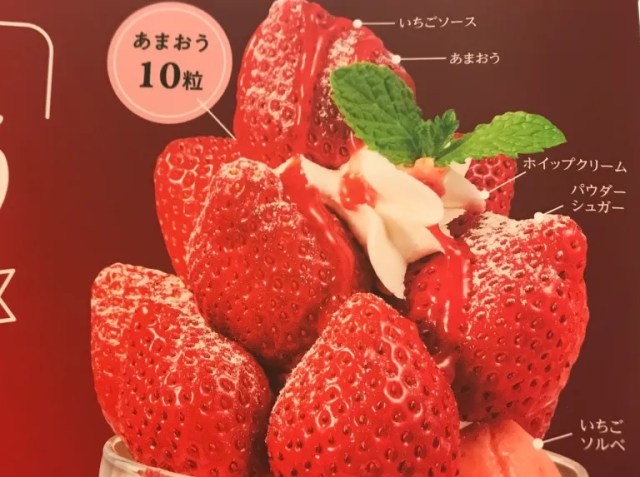

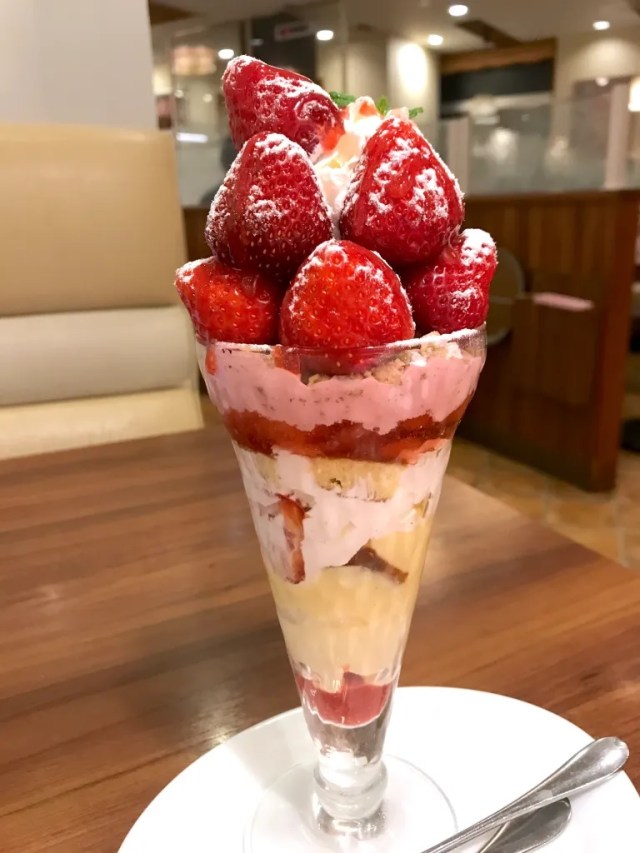

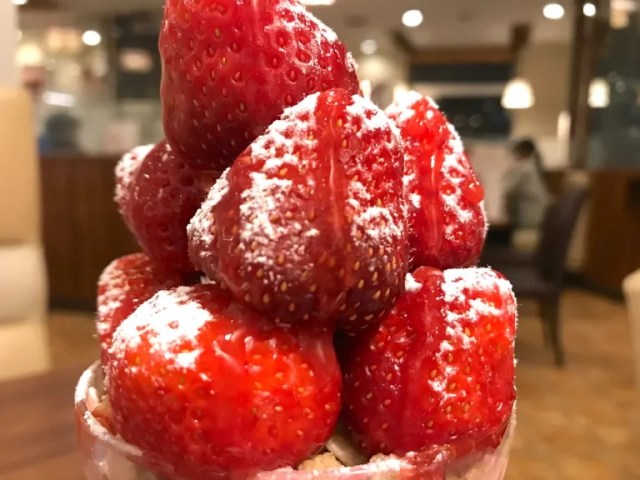
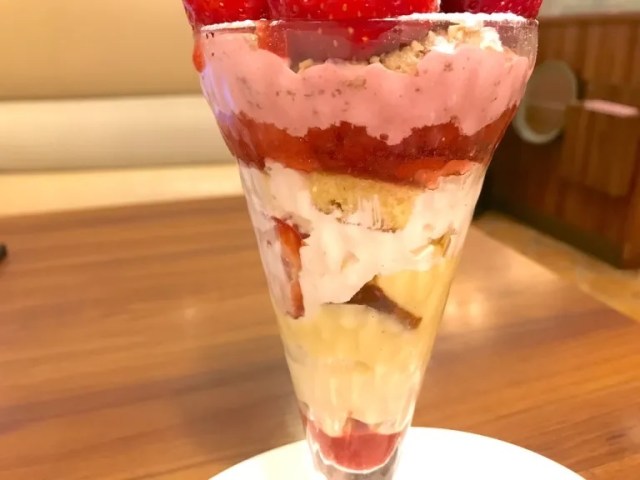
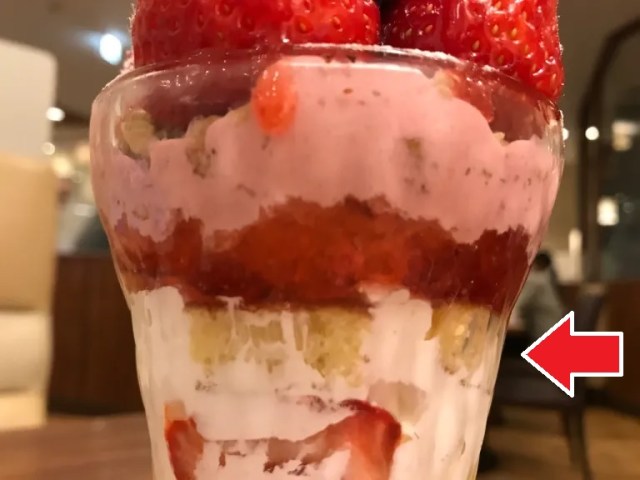

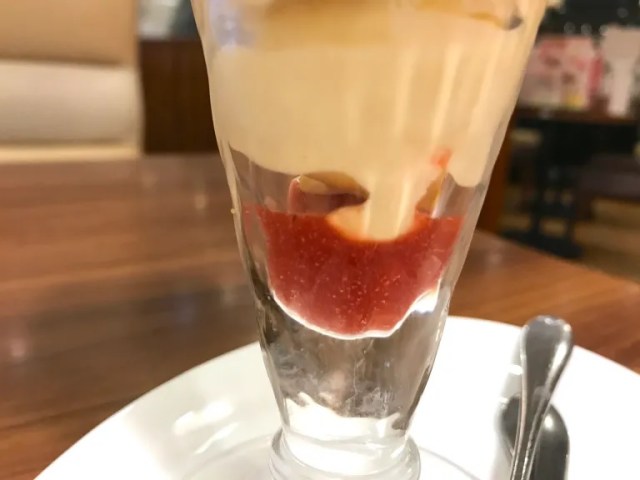

 Can our writers pick out the pricier strawberry shortcake against one over four times cheaper?
Can our writers pick out the pricier strawberry shortcake against one over four times cheaper? Fujiya’s new Mille-Feuille Burger spreads Japanese sweet tastes on crunchy, creamy cake buns
Fujiya’s new Mille-Feuille Burger spreads Japanese sweet tastes on crunchy, creamy cake buns Mister Donut’s new Angel Fruit series elevates angel cream doughnuts, takes taste buds to heaven
Mister Donut’s new Angel Fruit series elevates angel cream doughnuts, takes taste buds to heaven Sanrio characters take over Baskin Robbins Japan for My Melody and Kuromi’s Sweet Christmas
Sanrio characters take over Baskin Robbins Japan for My Melody and Kuromi’s Sweet Christmas Denny’s Japan collaborates with Godiva for decadent, limited-edition dessert menu
Denny’s Japan collaborates with Godiva for decadent, limited-edition dessert menu Foreigner’s request for help in Tokyo makes us sad for the state of society
Foreigner’s request for help in Tokyo makes us sad for the state of society Seaside scenery, history, and so many desserts on Yokohama’s Akai Kutsu【Japan Loop Buses】
Seaside scenery, history, and so many desserts on Yokohama’s Akai Kutsu【Japan Loop Buses】 Japanese city loses residents’ personal data, which was on paper being transported on a windy day
Japanese city loses residents’ personal data, which was on paper being transported on a windy day Should you add tartar sauce to Japanese curry rice? CoCo Ichi makes diners an unusual offer
Should you add tartar sauce to Japanese curry rice? CoCo Ichi makes diners an unusual offer French Fries Bread in Tokyo’s Shibuya becomes a hit on social media
French Fries Bread in Tokyo’s Shibuya becomes a hit on social media Osaka governor suggests lowering voting age to 0 to curb population decline
Osaka governor suggests lowering voting age to 0 to curb population decline Akihabara pop-up shop sells goods made by Japanese prison inmates
Akihabara pop-up shop sells goods made by Japanese prison inmates Mt. Koya planning to instate visitor’s tax to cope with huge tourist numbers
Mt. Koya planning to instate visitor’s tax to cope with huge tourist numbers Red light district sushi restaurant in Tokyo shows us just how wrong we were about it
Red light district sushi restaurant in Tokyo shows us just how wrong we were about it Pokémon Sleep camping suite and guestrooms coming to Tokyo Hyatt along with giant Snorlax burgers
Pokémon Sleep camping suite and guestrooms coming to Tokyo Hyatt along with giant Snorlax burgers McDonald’s new Happy Meals offer up cute and practical Sanrio lifestyle goods
McDonald’s new Happy Meals offer up cute and practical Sanrio lifestyle goods Japanese ramen restaurants under pressure from new yen banknotes
Japanese ramen restaurants under pressure from new yen banknotes Studio Ghibli releases new action figures featuring Nausicaä of the Valley of the Wind characters
Studio Ghibli releases new action figures featuring Nausicaä of the Valley of the Wind characters New private rooms on Tokaido Shinkansen change the way we travel from Tokyo to Kyoto
New private rooms on Tokaido Shinkansen change the way we travel from Tokyo to Kyoto Tokyo Tsukiji fish market site to be redeveloped with 50,000-seat stadium, hotel, shopping center
Tokyo Tsukiji fish market site to be redeveloped with 50,000-seat stadium, hotel, shopping center Beautiful Ghibli sealing wax kits let you create accessories and elegant letter decorations【Pics】
Beautiful Ghibli sealing wax kits let you create accessories and elegant letter decorations【Pics】 Studio Ghibli releases Kiki’s Delivery Service chocolate cake pouches in Japan
Studio Ghibli releases Kiki’s Delivery Service chocolate cake pouches in Japan New definition of “Japanese whiskey” goes into effect to prevent fakes from fooling overseas buyers
New definition of “Japanese whiskey” goes into effect to prevent fakes from fooling overseas buyers Our Japanese reporter visits Costco in the U.S., finds super American and very Japanese things
Our Japanese reporter visits Costco in the U.S., finds super American and very Japanese things All-you-can-drink Starbucks and amazing views part of Tokyo’s new 170 meter-high sky lounge
All-you-can-drink Starbucks and amazing views part of Tokyo’s new 170 meter-high sky lounge More foreign tourists than ever before in history visited Japan last month
More foreign tourists than ever before in history visited Japan last month New Pokémon cakes let you eat your way through Pikachu and all the Eevee evolutions
New Pokémon cakes let you eat your way through Pikachu and all the Eevee evolutions Disney princesses get official manga makeovers for Manga Princess Cafe opening in Tokyo
Disney princesses get official manga makeovers for Manga Princess Cafe opening in Tokyo Sales of Japan’s most convenient train ticket/shopping payment cards suspended indefinitely
Sales of Japan’s most convenient train ticket/shopping payment cards suspended indefinitely Sold-out Studio Ghibli desktop humidifiers are back so Totoro can help you through the dry season
Sold-out Studio Ghibli desktop humidifiers are back so Totoro can help you through the dry season Japanese government to make first change to romanization spelling rules since the 1950s
Japanese government to make first change to romanization spelling rules since the 1950s Ghibli founders Toshio Suzuki and Hayao Miyazaki contribute to Japanese whisky Totoro label design
Ghibli founders Toshio Suzuki and Hayao Miyazaki contribute to Japanese whisky Totoro label design Doraemon found buried at sea as scene from 1993 anime becomes real life【Photos】
Doraemon found buried at sea as scene from 1993 anime becomes real life【Photos】 Tokyo’s most famous Starbucks is closed
Tokyo’s most famous Starbucks is closed One Piece characters’ nationalities revealed, but fans have mixed opinions
One Piece characters’ nationalities revealed, but fans have mixed opinions We asked a Uniqlo employee what four things we should buy and their suggestions didn’t disappoint
We asked a Uniqlo employee what four things we should buy and their suggestions didn’t disappoint Princesses, fruits, and blacksmiths: Study reveals the 30 most unusual family names in Japan
Princesses, fruits, and blacksmiths: Study reveals the 30 most unusual family names in Japan We try the new Christmas Frappuccino from Starbucks Japan
We try the new Christmas Frappuccino from Starbucks Japan 3 convenience store ice creams you should buy at 7-Eleven in Kyushu
3 convenience store ice creams you should buy at 7-Eleven in Kyushu Bring a friend to eat Japan’s 5-kilogram (11-pound) strawberry parfait, or it will take you down
Bring a friend to eat Japan’s 5-kilogram (11-pound) strawberry parfait, or it will take you down Starbucks Japan unveils new Merry Strawberry Cake Frappuccino for Christmas 2019
Starbucks Japan unveils new Merry Strawberry Cake Frappuccino for Christmas 2019 Denny’s Japan offers mountain of pancakes and ice cream to guests on their birthday—for free!
Denny’s Japan offers mountain of pancakes and ice cream to guests on their birthday—for free! On-warabimochi: A delicious Japanese dessert you should only eat with people who already love you
On-warabimochi: A delicious Japanese dessert you should only eat with people who already love you Ikea holds a Matcha Fair in Japan for a limited time this spring
Ikea holds a Matcha Fair in Japan for a limited time this spring This sumptuous strawberry dessert at a Tokyo hotel is almost too stunning to stand
This sumptuous strawberry dessert at a Tokyo hotel is almost too stunning to stand McDonald’s Japan’s matcha dessert family grows with the new strawberry green tea Frappe
McDonald’s Japan’s matcha dessert family grows with the new strawberry green tea Frappe Our Starbucks “Nothingness” Frappuccino proves you can’t customise out flavour in Japan
Our Starbucks “Nothingness” Frappuccino proves you can’t customise out flavour in Japan Ikea Japan wants to furnish your stomach with matcha sweets with its new cafe dessert menu【Pics】
Ikea Japan wants to furnish your stomach with matcha sweets with its new cafe dessert menu【Pics】 Denny’s Japan introduces PokéNOMNOMNOM
Denny’s Japan introduces PokéNOMNOMNOM Baskin Robbins Japan releases spicy habanero sundae and glow-in-the-dark ice cream for Halloween
Baskin Robbins Japan releases spicy habanero sundae and glow-in-the-dark ice cream for Halloween Strawberry shortcake treat from Cold Stone Creamery becomes a convenience store drink
Strawberry shortcake treat from Cold Stone Creamery becomes a convenience store drink Small-you-can-eat: Japanese netizens are not happy with Denny’s new endless pancakes offer
Small-you-can-eat: Japanese netizens are not happy with Denny’s new endless pancakes offer
Leave a Reply